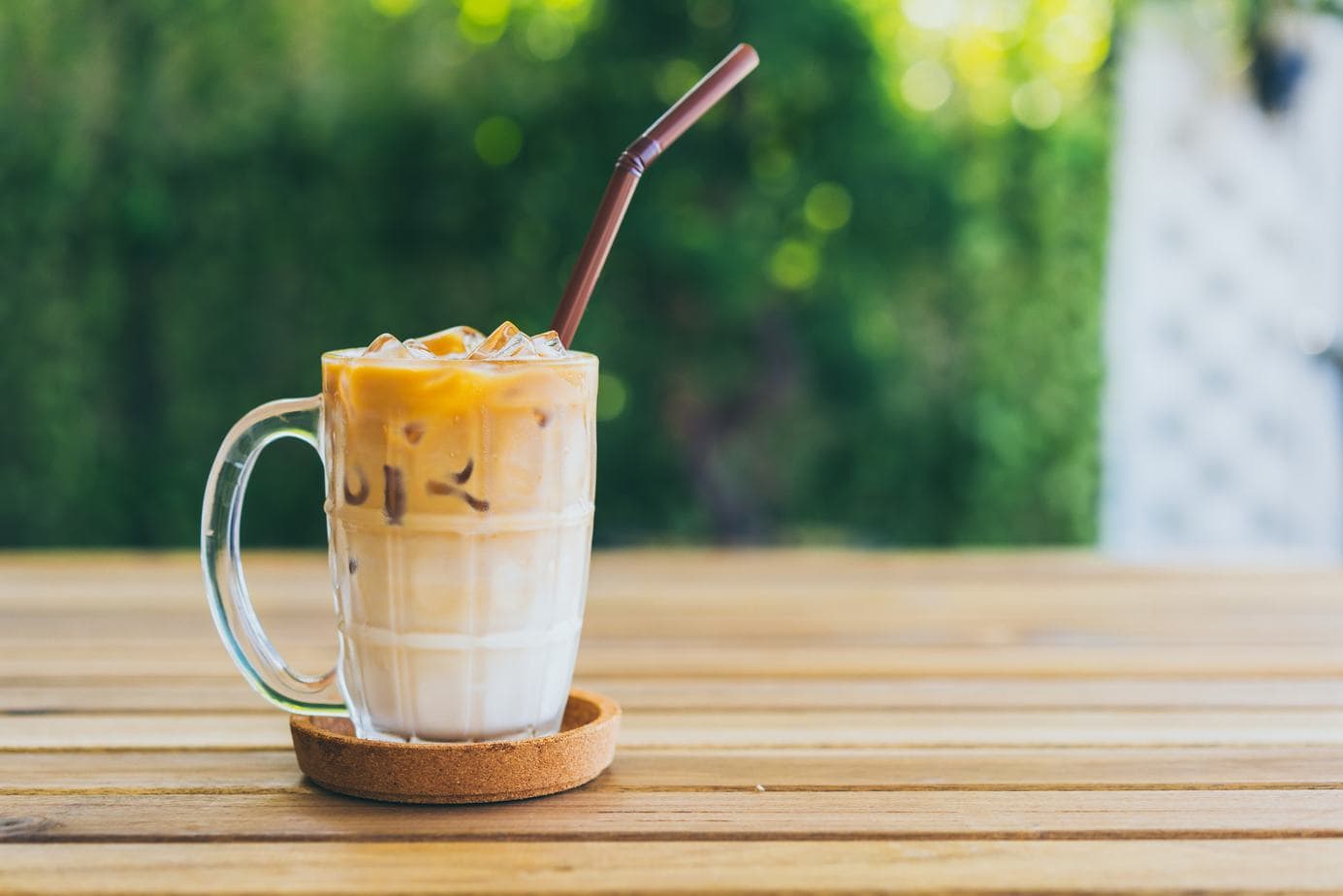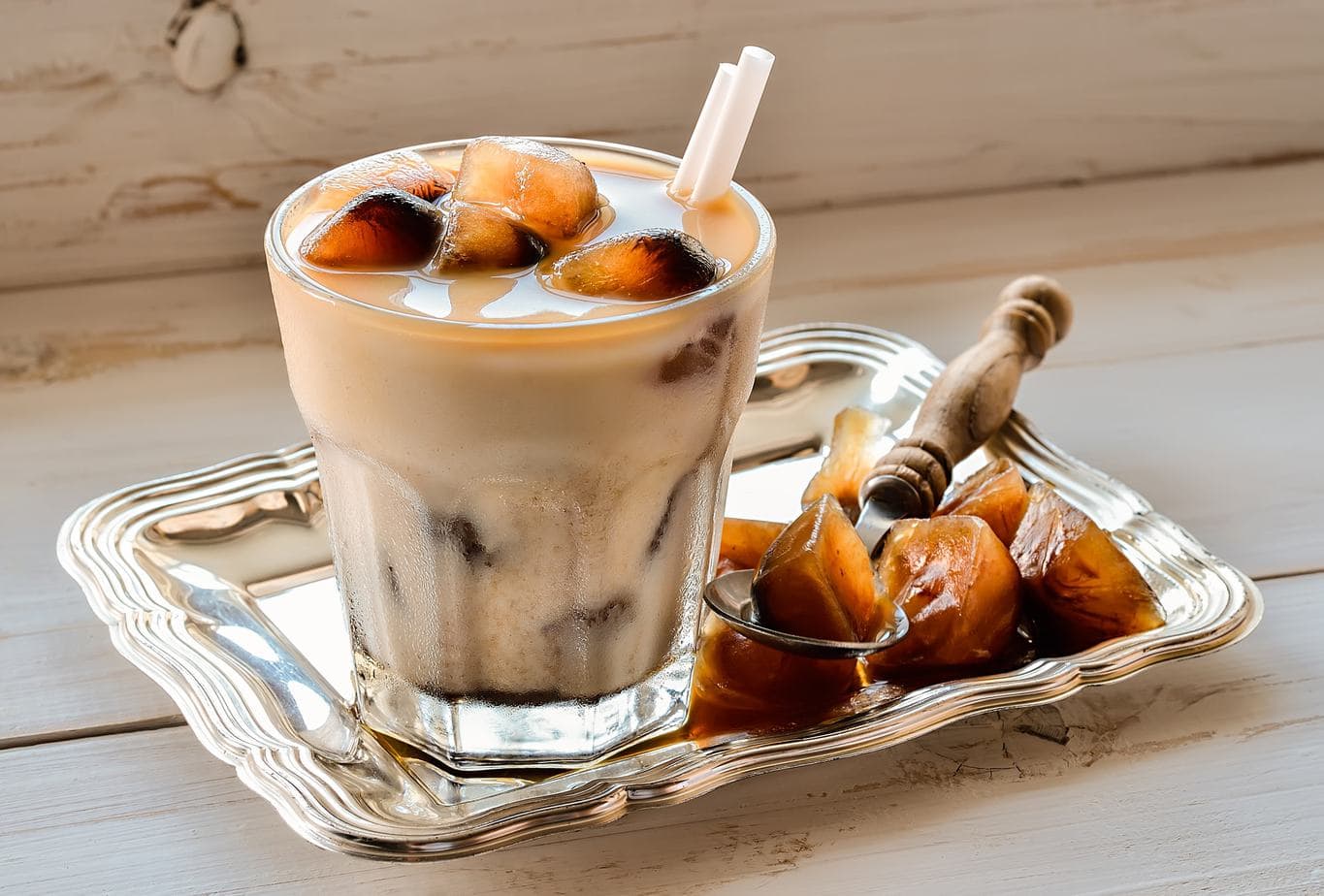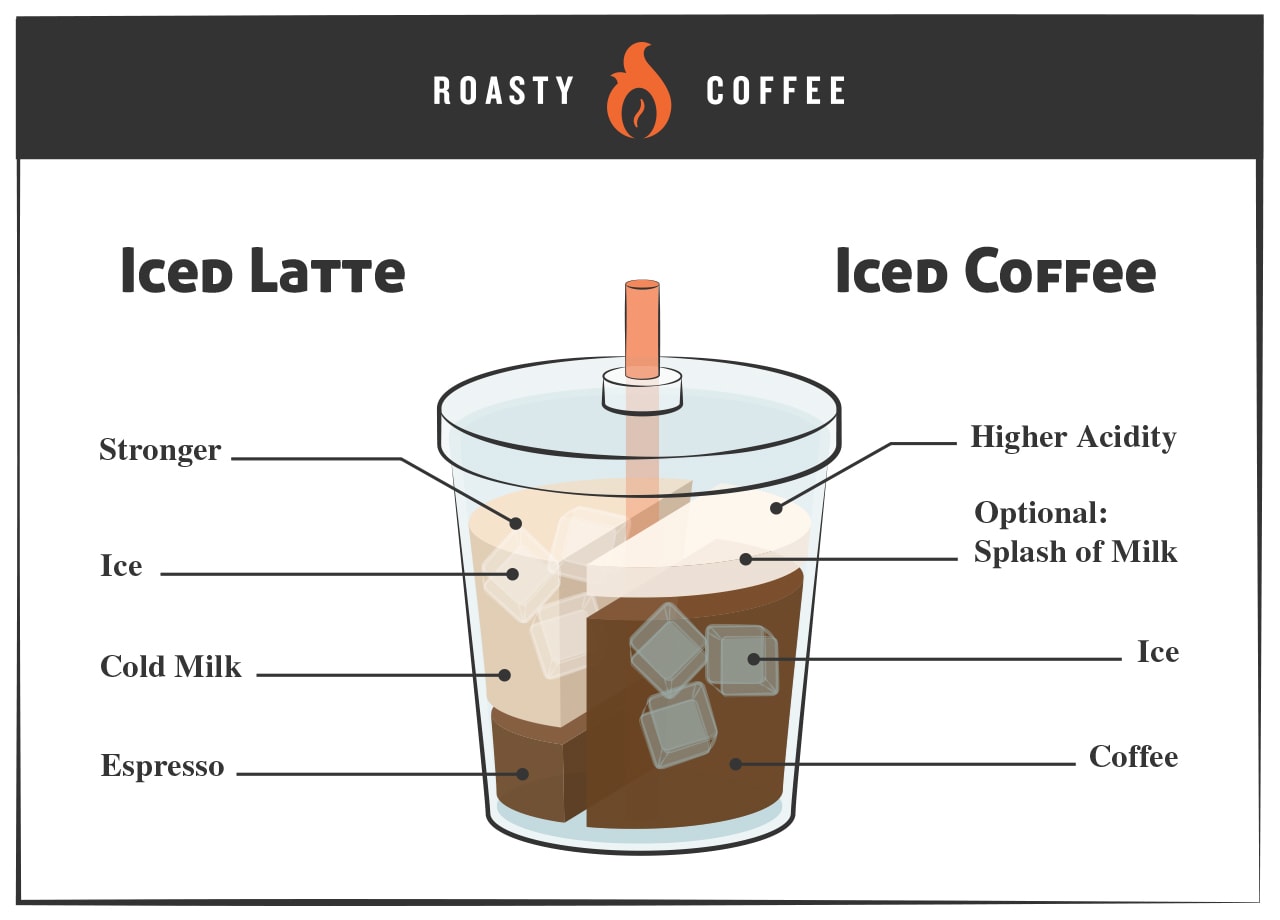As the weather heats up, we coffee drinkers need to switch up our usual coffee routine to something cooler without sacrificing our precious bean water. We have a few cold beverage options, including iced lattes and iced coffee.
Iced coffee or iced latte, what’s the difference?
At first glance, the difference between an iced latte and iced coffee is the same as the difference between espresso and coffee. Iced lattes contain espresso, while iced coffee uses, well, coffee. There’s more to the story, though, and we’ve got the details for you!
So if you’re a fan of coffee, and you want to enjoy the taste of coffee during the hot summer months, read on to learn everything you need to know about the iced latte vs. iced coffee debate. We’ll walk you through the key differences, how to make them, and how to choose which one is right for you!
What is an Iced Latte?

One of our favorite cold-weather drinks is a lightly flavored latte with steamed milk and espresso that warms us to our toes. As you know, the name cafe latte literally means coffee with milk in Italian. So, it’s hot coffee with milk added to it. However, as the summer heat rolls in, we lose our taste for a hot beverage that would only make us sweat bigger buckets.
Like hot lattes, the iced version uses espresso and milk. If you’re like us and appreciate a little flavor, you can use syrups or sauces.
How to Make an Iced Latte
It should be easy, right? All we have to do is dump our favorite latte over ice and dig in.
Wrong. Trust us; we tried it once as an experiment. We even added a double shot of espresso to account for the ice watering down the drink. It was completely disgusting and messy. The milk separated, and the whole thing tasted worse than week-old instant coffee from the bottom of the pot.
Yuck.
To create a delectable iced latte in the comfort of your own home isn’t rocket science, but it does require a little insight. Start with the right ingredients:
- Espresso coffee beans
- Ice
- Cold milk or milk alternative
- 12-ounce tall glass
Brew your espresso shot. Drop the ice into your glass, and then add milk until the glass is about ¾ full. Pour in the espresso and stir it. Sit back, take a sip, and revel in the deliciousness. But watch your ratios, or you’ll end up with a coffee milkshake.
Tips for Making a Better Iced Latte at Home
Even though it’s not as easy as dumping a hot latte over ice, making a true iced latte isn’t overwhelming. You can even up your game with a few simple tricks to craft a custom concoction worthy of a coffee shop!
- If you want to use flavored syrup, add it with your milk and mix well before adding the espresso.
- Try substituting your milk with blends. For example, using sweetened condensed milk for ¼ of the milk gives you a thicker, sweeter iced latte without using granulated sugar or sugar substitutes.
- Sprinkle flavored powders or spices over the top for added flavor and a pop of color.
- For an extra special treat, add a scoop of ice cream in place of the ice.
What About the Froth?
Do you love the creamy foam texture you get by steaming milk? We get it. Since you need cold milk for a proper iced latte, altering the texture requires a different approach. We know of two tried and true methods that can mimic the effects of a steaming wand.
You can use a milk frother to whip a little texture into cold milk to create cold foam before pouring it over the ice. Or, if you don’t have a frother sitting around, you can use a jar with a lid. Pour the milk into the jar, make sure you seal the lid tight, and shake, shake, shake to foam it up.
Does the Type of Milk Matter for an Iced Latte?
One of the fun aspects of drinking hot lattes is the awesome latte art in milk foam. Unfortunately, latte art doesn’t work as well with dairy alternatives due to texture and fat content. Since iced drinks don’t generally involve latte art, it doesn’t matter what type of milk or alternative you use.
That said, iced lattes open up a whole new world for those who can’t drink regular milk. Some people even prefer a dairy alternative, like almond or coconut, in their iced lattes because they tend to be lighter.
So…What is Iced Coffee?

It makes sense that you can’t pour a latte over ice to make an iced latte. But surely you can pour hot coffee over ice, right?
Wrong again. It seems like it would be easy to just brew some of your favorite coffee and pour it over ice. Maybe add a bit of milk or flavor to perk it up a bit. Though it doesn’t create quite the same mess as the iced latte experiment, pouring hot coffee over ice isn’t great.
Making Iced Coffee the Right Way
If you prefer to avoid choking down a gross cup of lukewarm diluted coffee, you’re in luck! Crafting a delightful iced coffee at home takes just a few simple steps. There are a few simple methods to make iced coffee, including large batch options. While everyone has their favorite iced coffee recipes, let’s start with a basic approach using a traditional coffee pot and a standard recipe.
Start with the ingredients:
- Your favorite coffee
- 12-ounce glass
- Ice
While you can brew your coffee like normal, it’s a good idea to increase your ingredient ratio to make it a little stronger to account for the ice melting. We find that a 1 ½ times system works well. For example, if you use six scoops of fresh grounds for six cups of water, try nine scoops of coffee with six cups of water to make the coffee stronger.
Set your fresh pot of coffee aside to cool down. Fill your glass with ice. Pour the cooled coffee over the ice. Voila! You have crafted an iced coffee that’s sure to taste amazing!
Tips for Making a Better Iced Coffee
Making a basic iced coffee is almost laughably easy with the proper ingredients. But, if you’d like to up your game, these tips and tricks can help you customize your new favorite drink.
- Add a splash of milk at the end for some color and texture.
- If you take your coffee with sugar, mix it in while the coffee is still hot so that it doesn’t collect at the bottom of your drink.
- To sweeten your drink without messing with sugar, try adding a few pumps of flavored coffee syrup. Note that sauces don’t work as well because they tend to be too thick.
- Don’t throw away leftover coffee! Instead, pour excess into ice cube trays to create coffee ice cubes to use for your next iced coffee.

How Does Iced Coffee Differ from Cold Brew?
While you have to wait a little bit for hot-brewed coffee to cool down, it’s a fraction of the time cold brew coffee takes. The main difference between iced coffee and cold brew is the brewing method.
Hot-brewed coffee uses heat to pull the flavor from those magic beans rather quickly. Some coffee pots can brew several cups in a matter of minutes. Even if you factor in a slightly longer brew time, you can take your first sip of an iced coffee in less than half an hour using the hot-brew method.
On the other hand, cold brew methods gradually extract flavor from the coffee beans. It takes at least 12 hours, though many connoisseurs recommend letting your coffee mixture sit for 18 to 24 hours for the best flavor.
Can’t I Just Add Milk to Iced Coffee or Cold Brew to Make a Latte?
No amount of milk can convert an iced coffee into an iced latte. Since iced lattes use espresso roast beans and iced coffees don’t, you can’t make one into another.
The Showdown: Iced Latte vs Iced Coffee
Okay, now that you know more about these kinds of coffee drinks, let’s break down the main differences between the two.
Strength
Is an iced latte stronger than iced coffee? Since iced lattes use espresso, you can expect a stronger coffee drink than the alternative. While you can certainly adjust the espresso and milk ratios in a latte or brew a stronger cup of coffee, it’s unlikely that any iced coffee wins this category.
Acidity
Iced lattes use espresso beans which naturally have lower acidity due to the longer roasting process. Like hot lattes, iced lattes use more milk than espresso, which rounds out the composition and levels out the acidity further. Even if you add a splash of milk to an iced coffee, it’s probably not enough to balance the acidity.
Equipment
It’s tough to talk about brewing at home without discussing the equipment you need to make the drinks. If you don’t have an espresso machine or Aeropress, you may not be able to make any espresso drinks.
Of course, some people argue that you can brew an espresso drink using anything you use to make regular coffee. Technically, that’s true. You can use espresso beans in something other than an espresso machine or Aeropress, but it’s not completely accurate.
To create that strong, intense shot of espresso, you need to apply hot water at hot pressure. That’s just not possible with a drip coffee pot, French press, or pour-over. Using espresso beans in an alternate system creates something like an espresso shot, but it won’t be the same.
Prep Time
Time is precious and waiting for your morning caffeine infusion can be downright frustrating. So, whether you choose an iced coffee or an iced latte, you can expect to spend a little time waiting. Both drinks require brewing, but waiting for hot-brewed coffee to become cold coffee before pouring it over the ice takes slightly longer.
Who Might Prefer an Iced Latte?
People who don’t normally drink coffee due to the acidity or bitter notes may prefer an iced latte. The milk rounds out the bitterness and eases the acidity so that it’s gentler on your digestive system.
Additionally, iced lattes work well with milk alternatives that add a little sweetness without infusing refined sugar. You can also add flavored syrups or sauces to add a punch of flavor.
What About an Iced Coffee?
Iced coffees aren’t usually the best option for non-coffee drinkers. Though they may not be as strong as lattes, you still get the bitterness, acidity, and stronger coffee flavor you’d expect from a cup of coffee. Even if you add a splash of milk, a bit of sugar, or some syrup, you won’t eliminate the distinct flavor or bitterness of the strong coffee brew.
Ice, Ice Baby
Iced latte vs iced coffee comes down to personal preference in cold drinks. They’re both popular types of coffee, but if you prefer a smooth drink with a little less acidity, then you may want to go with an iced latte. On the other hand, if you love that strong coffee bitterness and don’t mind waiting a little longer, then an iced coffee drink should work.
If you want a nice iced coffee at night, but don’t want to stay awake later than usual, try using decaf instant coffee to eliminate the caffeine content.
Like many coffee lovers, we have our personal preferences, but we don’t think you can lose with either option. At the end of the day, or rather the beginning of the day, it’s all about getting caffeinated drinks into our system!
Happy Caffeinating!

















